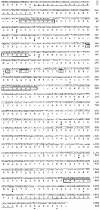Functional expression of a cDNA encoding a human ecto-ATPase
- PMID: 10510450
- PMCID: PMC1571647
- DOI: 10.1038/sj.bjp.0702805
Functional expression of a cDNA encoding a human ecto-ATPase
Abstract
1 The metabolism of extracellular nucleotides plays an important role in nucleotide signalling mediated by P2 receptors. The nucleotide sequence encoding a putative human ecto-ATPase named CD39L1 was reported recently. However, the biological activity of this protein has not been established. 2 Based on the sequence of CD39L1 we isolated from mRNA from human ECV-304 cells a sequence encoding a 495 amino acid protein that is identical to CD39L1, with the exception that this sequence contains a 23 amino acid stretch in the putative extracellular loop that is missing in CD39L1. Partial sequence of a genomic DNA clone indicates that the CD39L1 gene corresponds to an alternative spliced form of the human ecto-ATPase. 3 Stable expression of isolated sequence in NIH-3T3 mouse fibroblasts conferred a marked nucleotide hydrolytic activity consistent with the activity of an ecto-ATPase. 4 The human ecto-ATPase hydrolyzed all naturally occurring nucleoside triphosphates in a Ca(2+)- or Mg(2+)-dependent manner. Nucleoside diphosphates were hydrolyzed at a rate approximately 5% of that of the corresponding triphosphates. The apparent Km and Vmax values were: 394+/-62 microM and 107+/-7 nmol Pi min-1 10(6) cells-1 for the hydrolysis of ATP, and 102+/-33 microM and 4+/-0.4 nmol Pi min-1 10(6) cells-1 for the hydrolysis of ADP, respectively. 5 In conclusion, we report here the cloning and functional expression of a human ecto-ATPase. The study of the biochemical properties and the regulatory mechanisms of ecto-ATPases of defined sequence will be valuable in the definition of their role in nucleotide signalling.
Figures




References
-
- ABBRACCHIO M.P., BURNSTOCK G. Purinoceptors: Are there families of P2X and P2Y purinoceptors. Pharmac. Ther. 1994;64:445–475. - PubMed
-
- BEIGI R., KOBATAKE E., AIZAWA M., DUBYAK G.R. Detection of local ATP release from activated platelets using cell surface-attached firefly luciferase. Am. J. Physiol. 1999;276:C267–C278. - PubMed
-
- BOYER J.L., WALDO G.L., HARDEN T.K. Molecular cloning and expression of an avian G protein-coupled P2Y receptor. Mol. Pharmacol. 1997;52:928–934. - PubMed
-
- CHADWICK B.P., FRISCHAUF A.-M. Cloning and mapping of a human and mouse gene with homology to ecto-ATPase genes. Mammalian Genome. 1997;8:668–672. - PubMed
Publication types
MeSH terms
Substances
Grants and funding
LinkOut - more resources
Full Text Sources
Other Literature Sources
Molecular Biology Databases
Research Materials
Miscellaneous

